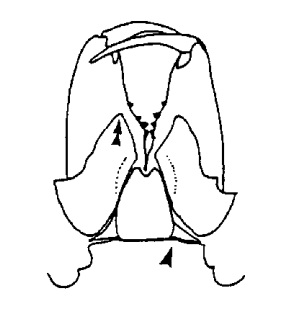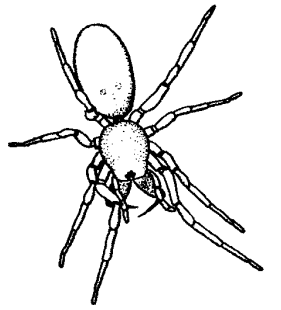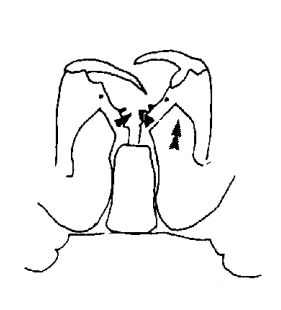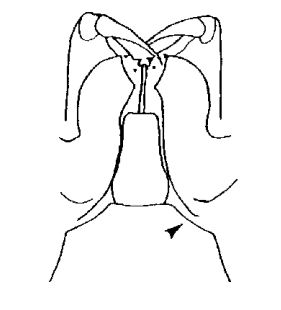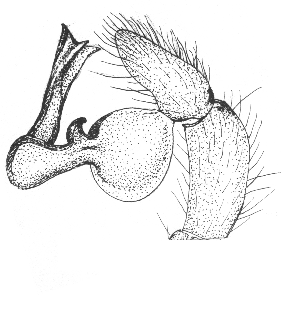Familie Dysderidae C. L. Koch, 1837
Schlüssel nicht vollständig. Weitere Gattungen sind am Ende aufgelistet. |
Für Fehlermeldungen oder Verbesserungsvorschläge bitte Link folgen: click
|
||||
| 1 |
Alle Tarsen mit Scopulae, Metatarsen der Hinterbeine mit Scopulae. Labium an der Ansatzstelle zum Sternum am breitesten (Dysderinae) |
||||
| - | Tarsen der Vorderbeine ohne Scopulae und mit 3 Krallen |
||||
| 2 (1) |
Bulbus des Männchens zylinderförmig |
||||
| - | Bulbus des Männchens kugelig |
||||
| 3 (2) |
3-4 Chelicerenzähne in einer Reihe, Vorderkante des Labiums mit deutlicher Kerbe, HMA weniger als 1 Durchmesser von HSA entfernt, Bulbus des Männchens aus 2 sklerotisierten Teilen mit grosser Apophyse, Vulva vorne mit bogenförmigem Divertikel |
| |||
| - | Anders |
||||
| 4 (3) |
Cheliceren mit 4 Zähne in zwei Reihen, Labium doppelt so lang wie breit, Bulbus an der Spitze mit breitem Chitinstreifen, Vulva vorne mit bogenförmigem Divertikel, HMA 0.5 – 1.5 Durchmesser von HSA entfernt |
||||
| - | Cheliceren mit 3 Zähnen in der vorderen und 2 Zähnen in der hinteren Reihe, HMA weniger als 0.5 Durchmesser von HAS entfernt, Bulbus mit einem kurzen und einfach Chitinstreifen an der Spitze, Vulva vorne mit einem umgekehrt T-förmigen Divertikel, hinten mit einem breiten Divertikel mit 2 Seitenflügeln |
||||
| 5 (2) |
Einfacher Bulbus mit einem langen, dünnen und oft gebogenen distalen Teil, HSA 1 Durchmesser von HMA entfernt |
| |||
| - | Bulbus mit 2 subapikalen Apophysen |
||||
| 6 (1) |
Labium in seiner Mitte annähernd so breit wie an der Ansatzstelle zum Sternum; chitinöser Streifen zwischen den Coxen, nicht jedoch zwischen Coxa 1 und Maxillen (Harpacteinae) |
| |||
| - | Labium in seiner Mitte deutlich schmäler wie an der Ansatzstelle zum Sternum; chitinöser Streifen zwischen den Coxen und zwischen Coxa 1 und Maxillen (Rhodinae) |
||||
| 7 (6) |
Sternum matt; Embolus meist länger als Bulbus, an der Basis gewinkelt, Bulbus mit deutlich vorstehender Struktur; Vulva völlig sklerotisiert, vorderer Teil umgekehrt T-förmig |
| |||
| - | Anders |
||||
| 8 (7) |
Bulbus kugelig mit dünnem, querverlaufenden Embolus |
||||
| - | Bulbus nicht kugelig, Embolus anders |
||||
| 9 (8) |
Augen bilden einen Ring, die Hinteraugen berühren sich; Sternum glänzend; distaler Bulbusfortsatz nicht länger als der Bulbus, 2-3 oft pinzettenförmige Fortsätze Harpactea |
||||
| - | Anders |
||||
| 10 (9) |
Bulbus mit einer sehr grossen, gebogenen Apophyse mit Zähnen und Loben, 1 Art von Korsika |
||||
| - | Anders |
||||
| 11 (10) |
Augen reduziert oder fehlend, Vulva mit umgekehrt V- oder Y-förmiger Spermathek, das breite hintere Divertikel nicht sklerotisiert |
||||
| - | Mittelaugen kleiner als Seitenaugen, Beine stachellos, Vulva mitv stabförmiger Spermathek, hinteres Divertikel nicht sklerotisiert |
||||
| 12 (8) |
Augen bilden einen Ring, die Hinteraugen berühren sich; Sternum glänzend; distaler Bulbusfortsatz nicht länger als der Bulbus, 2-3 oft pinzettenförmige Fortsätze |
||||
| - | Augen reduziert oder fehlend |
||||
| 13 (12) |
Tibia II ohne Stacheln Harpactea |
||||
| - | Tibia II mit Stacheln |
||||
| 14 (12) |
Bulbus einfach, 2 Höhlenarten aus Kreta |
||||
| - | Bulbus mit breitem Embolus, eine Höhlenart aus Spanien |
||||
| 15 (6) |
Beine ohne Stacheln, hinterer Teil des Prosoma in der Mitte mit Lobus |
||||
| - | Anders |
||||
| 16 (15) |
Mesostalita, Stalita und Parastalita: Distaler Teil des Bulbus mit einer Reihe oder einem Feld von Zähnen oder Stacheln (Bei 3 von 8 Arten ist jeweils nur ein Geschlecht bekannt und die Abgrenzung der Gattungen ist nicht eindeutig) |
||||
| - | |||||
| - | |||||
| - | Distaler Teil des Bulbus ohne Zähnen oder Stacheln |
Weitere Gattungen
- 1. Cryptoparachtes
- 2. Kut
- 3. Rhodera
- 4. Sardostalita
- 5. Stalitochara
